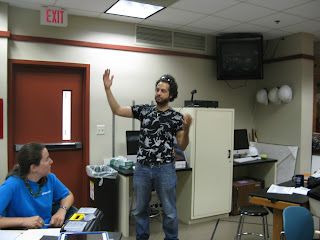Later in the morning we made models of atoms by using Neil Bohr's model of the atom. We learned why some atoms are highly reactive ( see Hindenberg clip) and why some don't interact at all with other atoms. We learned about electron energy levels and photons. Then our docent. Lori, gave a brief explanation of the group of particles known as quarks.
Before lunch, Susan Dahl visited and told us about the Teacher Resource Center and all the wonderful opportunities that Friends of Fermilab provide for teachers and students.
After lunch we began looking at the properties of matter. We identified property words for solids and we explored gas pressure laws. Our favorite demo was the egg in the bottle experience. We then showed how strong air pressure is by using a piece of tag board to hold back an entire bottle of water.
We concluded by placing a participant into a 39 gallon trash bag and removing most of the air with a shop vac. The results were crushing!
This was a wonderful group of inquisitive and engaging teachers. They demonstrated the true meaning of professionalism and their students are fortunate to have them for teachers as they facilitate learning in the upcoming school year.






















































